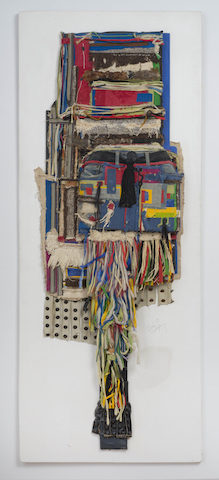Wexner Center for the Arts, The Ohio State University
January 30 – April 10, 2016
This winter, the Wexner Center for the Arts will present the exhibition, Noah Purifoy: Junk Dada, in the entirety of its four galleries. PFW will be a Sponsor of this three-month exhibition. Junk Dada is the first solo exhibition of this scale to survey Purifoy’s remarkable body of work since his death in 2004. Purifoy was captivated by Dada, an avant-garde movement of the early 20th century, and the notion of the readymade. The influence of these art historical precedents is felt from the earliest to latest work in this exhibition, and the title of the show is drawn from how Purifoy incorporated Dada into his own artistic vernacular with materials and found objects considered refuse or junk, taking it a step further by delving into the realm of assemblage in the midst of the turbulent socio-historical milieu of the sixties and seventies.It was the infamous Watts Rebellion in August 1965 that set him on his artistic path and indelibly influenced his artistic practice:
“While the debris was still smoldering, we ventured into the rubble like other junkers of the community, digging and searching, but unlike others, obsessed without quite knowing why.”
From the destruction, Purifoy and his peers made art from some three tons of rubble they had amassed—work that was shown in the exhibition, 66 Signs of Neon, which traveled throughout the U.S. from 1966 to 1972, eventually making its way across the Atlantic to Berlin. “These art things have come from discards and wastes of a man-made world. They return to it as messages concerning man and his life. You will need to look hard and think deeply to grasp the messages…it took hard work and struggle to produce them, and it is hard work to understand them. But so it is, with most worthwhile
things.” —Noah Purifoy, 1971
The Watts Rebellion
In August 1965, some 30,000 black Angelenos took to the streets of the Watts neighborhood in Los Angeles. They were protesting the arrest of Watts resident Marquette Frye and his brother, for allegedly speeding and resisting arrest, as well as their mother, who had attempted to intervene. While these events are credited with sparking the revolt, unrest in Watts had been building in the years since the massive migration of African Americans to the West Coast following World War II. Precipitated by harsh racial inequalities that had manifested in housing, education, employment, and political discrimination, the five-day revolt resulted in:
· 14,000 National Guard troops deployed to patrol the street, 4,000 arrests, 1,032 injuries, 34 deaths, $40 million in property damage
Tragically, the Watts Rebellion did not significantly improve the lives of the community’s black residents. While President Lyndon B. Johnson’s War on Poverty programs were implemented to address the rampant inequality, much of that money was eventually usurped by the Vietnam War. Source: www.blackpast.org
This year PFW has sponsored the WEX’s educational program PAGES, as well as being a contributing sponsor for their screening and forum for Cincinnati Goddam! and the Black Box performance of American Power. PFW LOVES THE WEX WE HOPE YOU DO TOO!
Photo courtesy of Tilton Gallery, New York “For Lady Bird,” 1987-89





